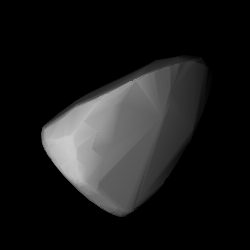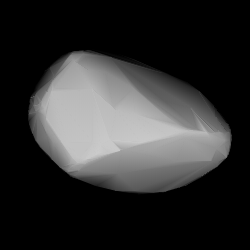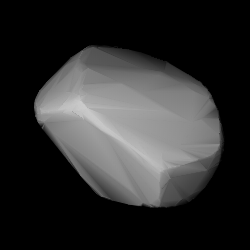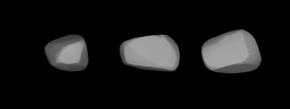Abnoba, provisional designation 1900 FH, is a stony background asteroid from the central regions of the asteroid belt, approximately 40 kilometers in diameter. It was discovered on 4 June 1900, by astronomers Max Wolf and Arnold Schwassmann at the Heidelberg-Königstuhl State Observatory in southwest Germany. The asteroid was named after the Celtic deity Abnoba.
789 Lena, provisional designation 1914 UU, is a metallic asteroid from the middle region of the asteroid belt, approximately 24 kilometers in diameter. It was discovered on 24 June 1914, by Soviet–Russian astronomer Grigory Neujmin at Simeiz Observatory on the Crimean peninsula, and named after the discoverer's mother.
1178 Irmela, provisional designation 1931 EC, is a stony asteroid from the middle regions of the asteroid belt, approximately 19 kilometers in diameter.
1043 Beate, provisional designation 1925 HB, is a stony asteroid from the outer region of the asteroid belt, approximately 32 kilometers in diameter. It was discovered by German astronomer Karl Reinmuth at the Heidelberg-Königstuhl State Observatory on 22 April 1925. Any reference of its name to a person is unknown.
1096 Reunerta, provisional designation 1928 OB, is an asteroid from the background population of the asteroid belt's central region, approximately 40 kilometers in diameter. It was discovered on 21 July 1928, by astronomer Harry Edwin Wood at the Union Observatory in Johannesburg, South Africa. The asteroid was named after South African engineer Theodore Reunert, supporter of the observatory and friend of the discoverer.
1550 Tito, provisional designation 1937 WD, is a stony asteroid from the middle region of the asteroid belt, approximately 12 kilometers in diameter. It was discovered on 29 November 1937, by Serbian astronomer Milorad B. Protić at the Belgrade Astronomical Observatory in Serbia. It was named for Yugoslavian statesman Josip Broz Tito.

1554 Yugoslavia, provisional designation 1940 RE, is a stony Eunomian asteroid from the middle region of the asteroid belt, approximately 16 kilometres (9.9 mi) in diameter. It was discovered by Serbian astronomer Milorad Protić at Belgrade Astronomical Observatory, Serbia, on 6 September 1940. It was named for the former country of Yugoslavia.
1146 Biarmia, provisional designation 1929 JF, is a metallic background asteroid from the outer regions of the asteroid belt, approximately 32 kilometers in diameter. It was discovered on 7 May 1929, by Russian astronomer Grigory Neujmin at the Simeiz Observatory on the Crimean peninsula. The asteroid was named for the Bjarmaland mentioned in Norse sagas.

1160 Illyria, provisional designation 1929 RL, is a stony Maria asteroid from the central regions of the asteroid belt, approximately 13 kilometers in diameter. It was discovered on 9 September 1929, by German astronomer Karl Reinmuth at the Heidelberg Observatory in southwest Germany. The asteroid was named after the ancient region of Illyria, located on the Balkan Peninsula.
16765 Agnesi is a stony Eunomia asteroid from the middle region of the asteroid belt, approximately 4 kilometers in diameter. It was discovered on 16 October 1996, by Italian-American amateur astronomer Paul Comba at his private Prescott Observatory in Arizona, United States. The asteroid was named after Italian mathematician Maria Gaetana Agnesi.
4175 Billbaum, provisional designation 1985 GX, is a background asteroid from the central regions of the asteroid belt, approximately 9 kilometers in diameter. It was discovered on 15 April 1985, by American astronomer Edward Bowell at the Anderson Mesa Station of the Lowell Observatory near Flagstaff, Arizona. The uncommon L-type asteroid has a short rotation period of 2.73 hours and was named for American astronomer William A. Baum.

1333 Cevenola, provisional designation 1934 DA, is a binary Eunomian asteroid from the asteroid belt, approximately 15 kilometers in diameter. It was discovered on 20 February 1934, by French astronomer Odette Bancilhon at Algiers Observatory, Algeria in Northern Africa. It was named after the French mountain-range Cévennes, via the Occitan feminine adjective/demonym cevenòla.
6296 Cleveland, provisional designation 1988 NC, is a Hungaria asteroid from the innermost regions of the asteroid belt, approximately 3.5 kilometers in diameter. It was discovered on 12 July 1988, by American astronomer Eleanor Helin at the Palomar Observatory in California. The presumed E-type asteroid has a long rotation period of 30.8 hours and possibly an elongated shape. It was named for the city of Cleveland in the U.S. state of Ohio.
5333 Kanaya, provisional designation 1990 UH, is a carbonaceous asteroid from the inner regions of the asteroid belt, approximately 14 kilometers in diameter.
1384 Kniertje, provisional designation 1934 RX, is a dark Adeonian asteroid from the central regions of the asteroid belt, approximately 26 kilometers in diameter. It was discovered on 9 September 1934, by Dutch astronomer Hendrik van Gent at the Union Observatory in Johannesburg, South Africa. The asteroid was named after a character in the Dutch play Op Hoop van Zegen by Herman Heijermans.
1284 Latvia, provisional designation 1933 OP, is a rare-type asteroid from the middle region of the asteroid belt, approximately 37 kilometers in diameter. It was discovered on 27 July 1933, by German astronomer Karl Reinmuth at Heidelberg Observatory in southern Germany, and named after the Republic of Latvia.
1318 Nerina, provisional designation 1934 FG, is a Phocaea asteroid from the inner regions of the asteroid belt, approximately 13 kilometers in diameter. It was discovered on 24 March 1934, by South African astronomer Cyril Jackson at the Union Observatory in Johannesburg. The possibly metallic X-type asteroid has a notably short rotation period of 2.5 hours. It was named for the flowering plant Nerine, also known as "Guernsey lily" or "Jersey lily".
3406 Omsk, provisional designation 1969 DA, is a background asteroid from the central regions of the asteroid belt, approximately 15 kilometers in diameter. It was discovered on 21 February 1969, by Soviet astronomer Bella Burnasheva at the Crimean Astrophysical Observatory on the Crimean peninsula in Nauchnij. The possibly metallic M/X-type asteroid has a rotation period of 7.3 hours. It was named for the Russia city of Omsk.

1663 van den Bos, provisional designation 1926 PE, is a stony Florian asteroid and an exceptionally slow rotator from the inner regions of the asteroid belt, approximately 12 kilometers in diameter. It was discovered on 4 August 1926, by English astronomer Harry Edwin Wood at Johannesburg Observatory in South Africa. It was later named after astronomer Willem Hendrik van den Bos.
1481 Tübingia, provisional designation 1938 DR, is a dark asteroid from the outer region of the asteroid belt, approximately 34 kilometers in diameter. It was discovered on 7 February 1938, by German astronomer Karl Reinmuth at Heidelberg Observatory in southern Germany, and named for the German city of Tübingen.




